Have you ever wondered where does food come from before it makes it to the grocery store? A Kansas farm food tour is a great way to find the answer.
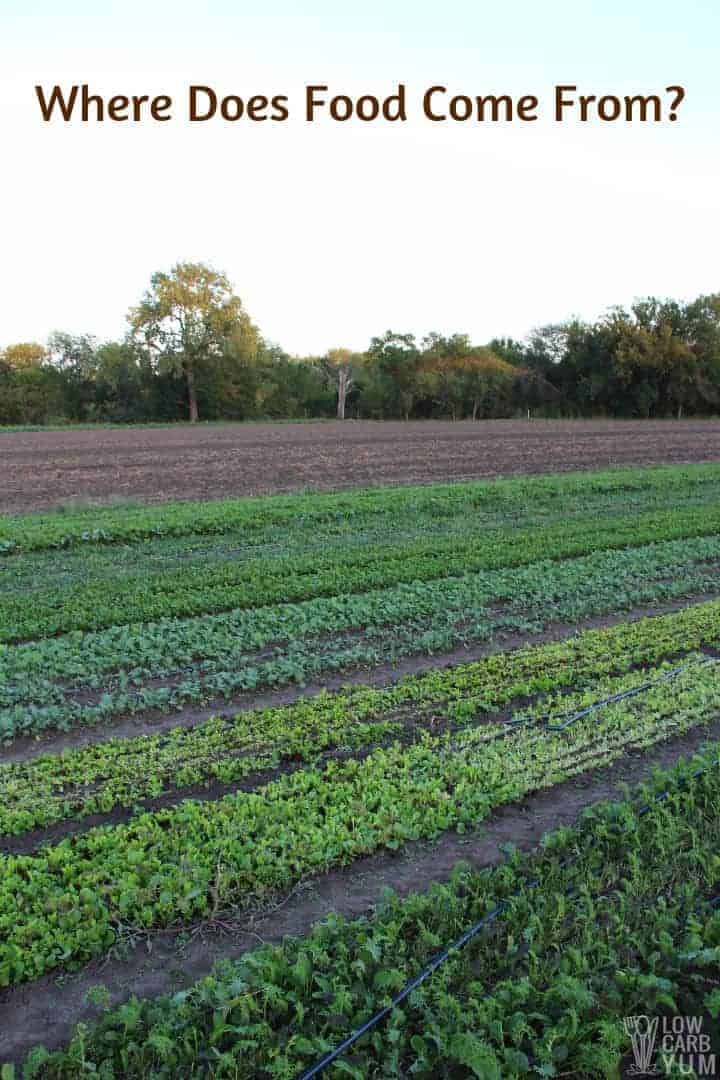
Article Index
Disclaimer: This post has been sponsored by the Kansas Farm Bureau and the Kansas Soybean Commission, but all opinions are my own.
As a food blogger, I felt that I knew a lot about food. But it turns out that I didn't know as much as I thought I did.
Last month, I participated in a three day Farm Food Tour hosted by the Kansas Farm Bureau and the Kansas Soybean Commission. The trip significantly changed the way I look at food. And, it made me feel a lot better about the food grown in the United States.
The tour included the following Kansas farms located throughout the state:
- Good Farms in Olsburg
- Sawyer Land & Cattle in McPherson
- France Family Farms in Marienthal
- Reeve Cattle Company in Garden City
- Forget-Me-Not Dairy in Cimarron
- Dalebanks Angus Ranch in Eureka
- Juniper Hill Farms in Lawrence
I was one of several bloggers in the group. We were also joined by a farmer, a dietician, a camera crew from New Boston Creative, as well as our hosts from the Kansas Farm Bureau and the Kansas Soybean Commission.
Below is a recap of the tour. And it was a great way to answer the question, "Where does food come from?"
Heritage Pork on Good's Pig Farm
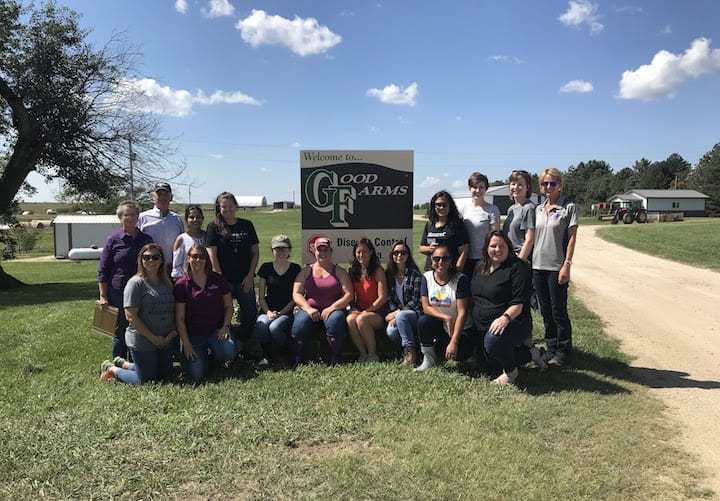
The first stop on the tour was the cleanest pig farm I have ever seen. This pristine farm is owned by Craig and Amy Good. When they were struggling to make a profit on pig farming, a New York company contacted them about an opportunity to raise pure breed pigs.
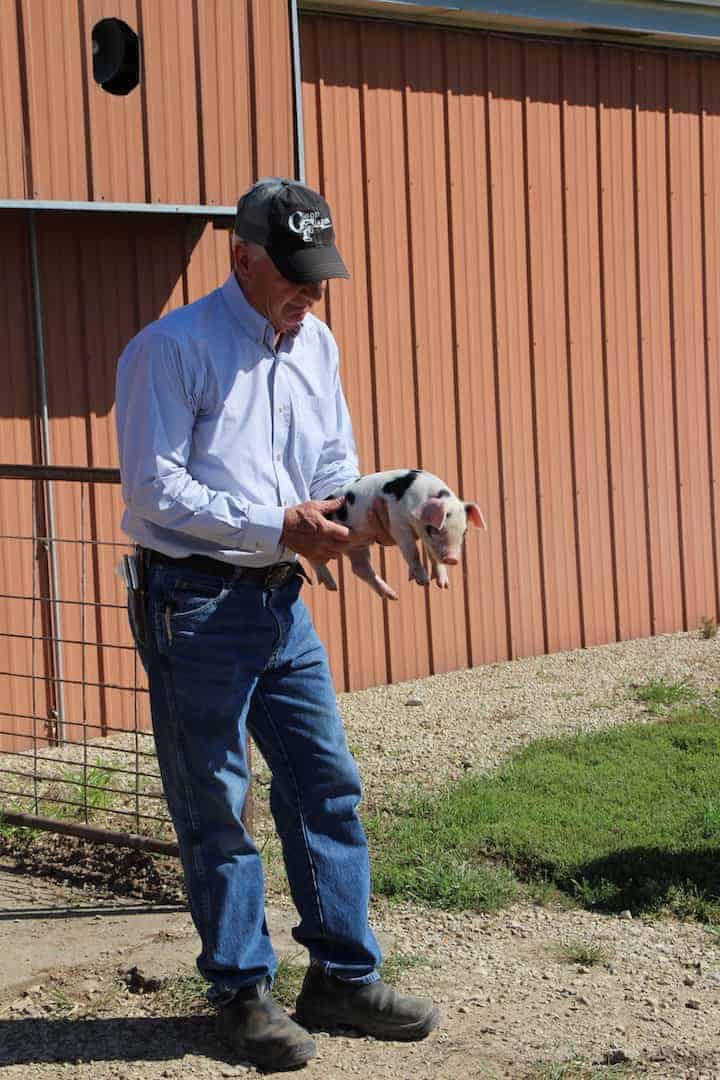
Although it's harder to raise the pure breeds, the move into the heritage pork niche allowed the Goods to prosper again. Most of the pork raised on their farm is sold directly to restaurants through the company Heritage Foods USA.
It takes about 6 months for pigs to mature on the farm from birth in a litter to harvesting the meat in a packing facility. During their time on the farm, the pigs are well cared for and each one is uniquely identified by notches in their ears.
The health of each pig is well monitored. After weaning off milk, the piglets are moved to a diet that's primarily a mix of corn and soy. The feed has been scientifically developed to raise healthy animals with high quality meat. I was surprised to learn that a type of seaweed was added to the feed which helps to boost the immune system in the pigs by maintaining a healthy gut microbiome.
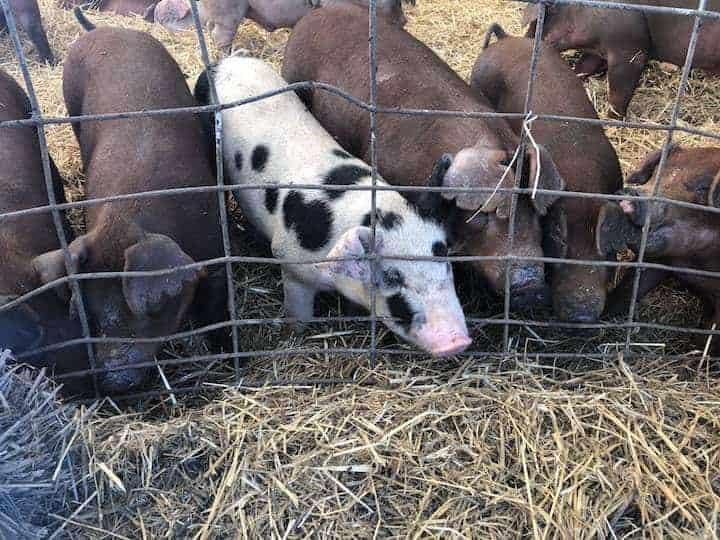
Use of antibiotics are discouraged so keeping the pigs in good health is a top priority. In fact, the pigs are located within a disease control area. We had to wear plastic booties to enter the area and weren't allowed to touch the animals.
Pigs with the best genetics are used for breeding and it's all done through artificial insemination. Males that aren't used for breeding are castrated to prevent tainting the meat with a boar odor. It also prevents aggressive behavior in the male pigs.
We got to see all the various stages of pigs on the farm. There is the breeding area where the boars are kept, the birthing and farrowing area, the pig growing area, the sow area, and the finishing area. Despite what I've read, the pigs all seemed to be living a content life on the farm.
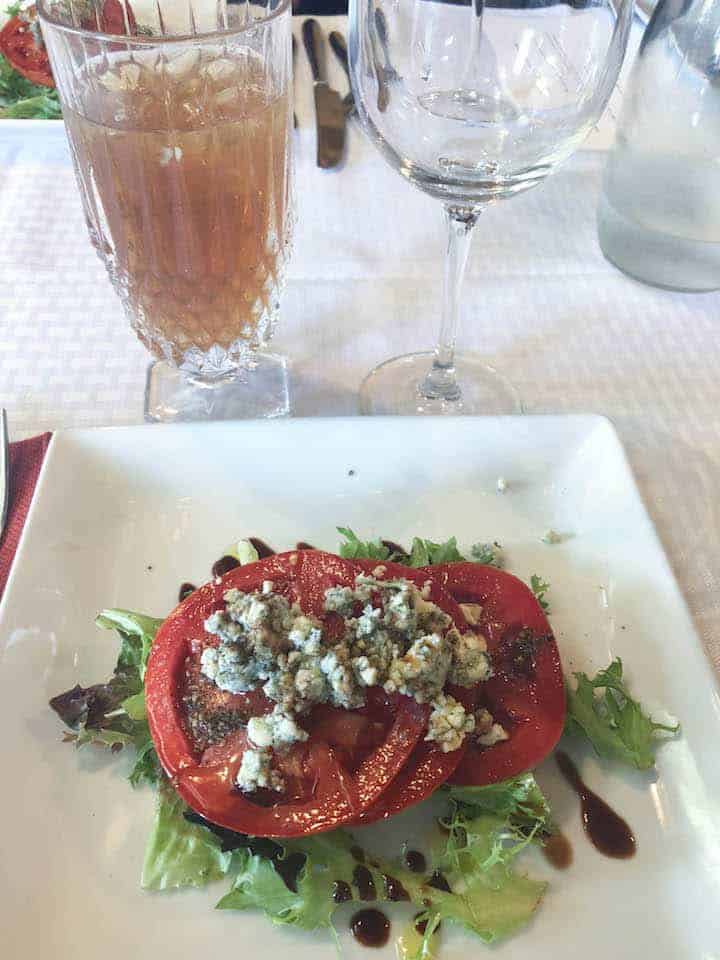
Our visit to Good Farms ended with a wonderful lunch catered by Little Apple Brewery from Manhattan Kansas. The meal began with a gorgeous salad made with field greens, Maytag Bleu cheese, and the famous Jakes Beefsteak Tomatoes.
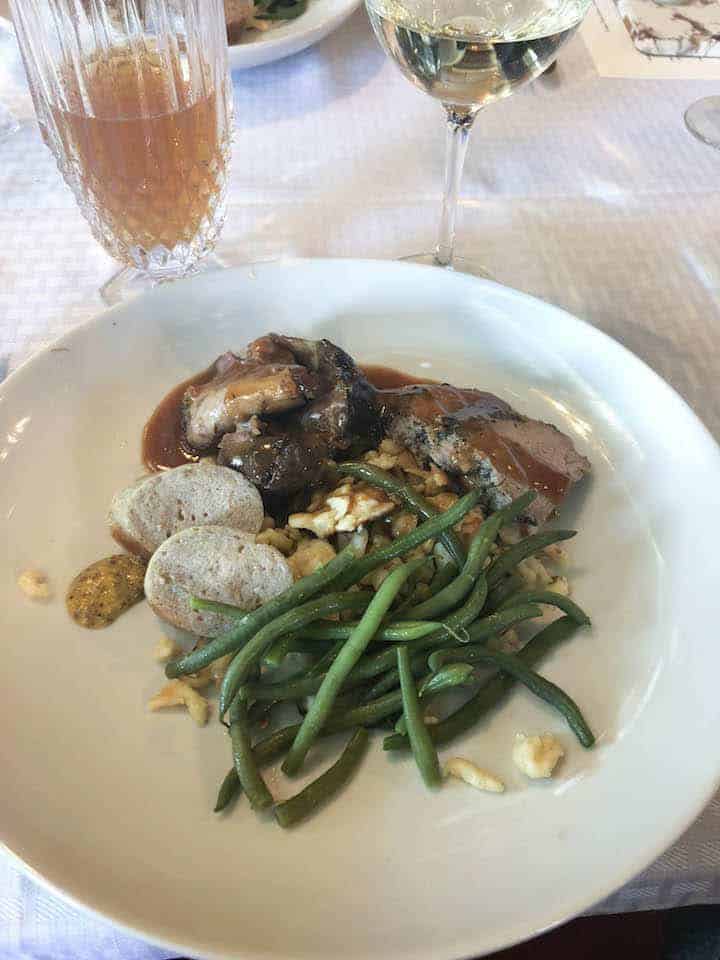
The main dish for lunch featured Good Farms Spotted Gloucestershire Pork Tenderloin and Braised Pork Shank. The pure breed pork from the Good's farm was amazing!
Harvesting Corn on the Sawyer's Farm
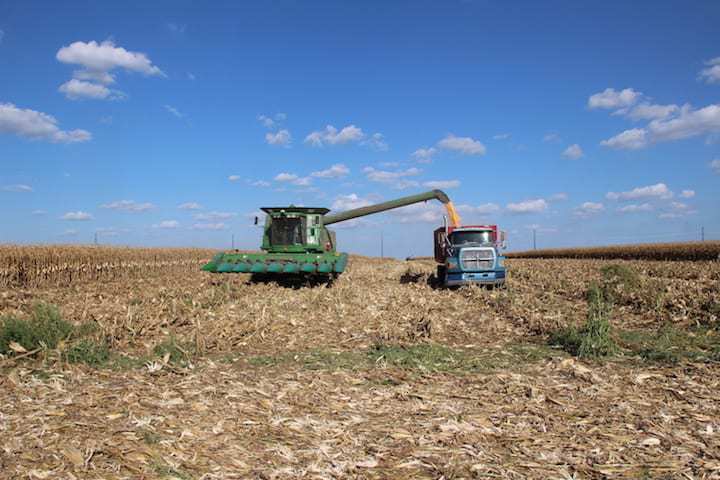
After a couple hours of driving, we stopped in on the Sawyer's land while they were harvesting corn used for cattle feed using a combine machine. To be honest, I've always wondered how they get all the corn from acres and acres of plants.
Most of the corn grown in Kansas isn't the sweet corn that you find in the grocery store. It's grown primarily to feed livestock and to make ethanol. And, it's harvested after it's dried down and the plant is no longer green. When I saw the combine going through a dried up corn field, I was surprised that it was harvest time since the corn in our area is picked when the husks are still green. But that's because it's corn grown for feeding animals and not people.
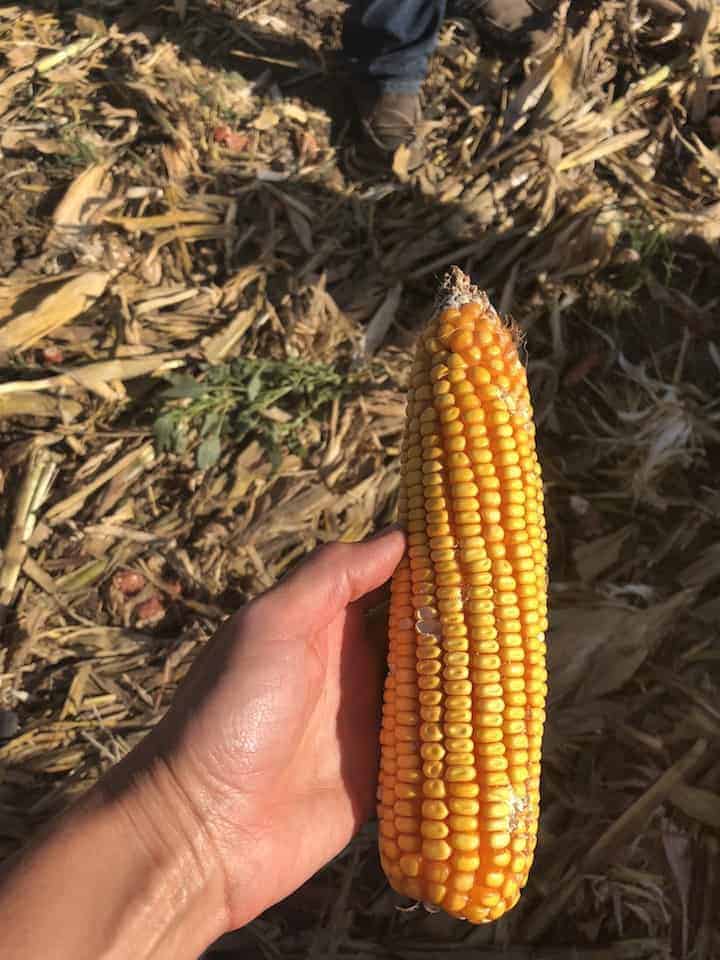
The Sawyer's cattle weren't on the farm during our visit. They were off visiting the pasture where they graze on grasses while the land is used for growing row crops. We got to visit one of these cow pastures in the Flint Hills of Kansas on the last day of the tour.
The Sawyers told us it's tough to make a living in farming but it's something they enjoy and it's the lifestyle they chose. Farmers need to balance methods for weeding, chemical use, and tilling. The corn they were harvesting was a drought tolerant GMO variety. GMO crops help them make the best use of the resources they have and farm most efficiently which helps to reduce overall costs.
France Family Farms Soybeans
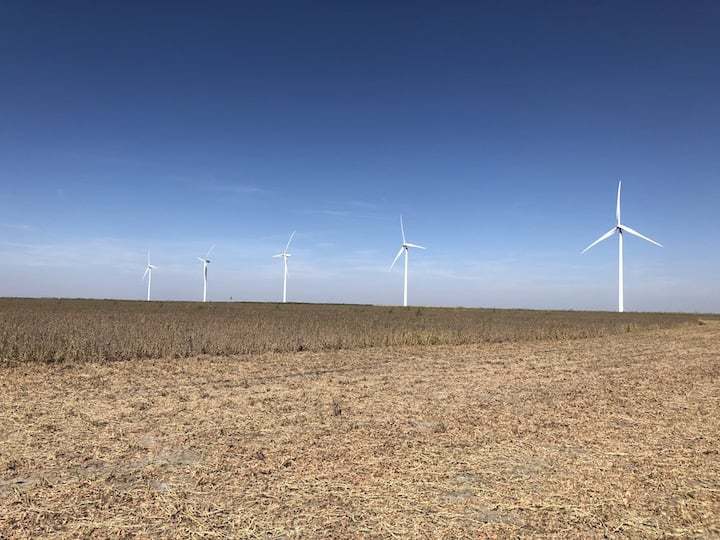
The first stop on Day 2 of the tour was Amy and Clint France's soybean field with a quick stop at their farm house. Amy is the farmer who joined us for the tour and she made sure the right questions were asked on each stop. She also made sure we were able to identify the crops we saw growing as we drove through rural Kansas. And there certainly were lots of soybeans and sorghum in those fields.
Although I was told it usually isn't as windy as it was during our visit, I'm pretty sure those wind turbines next to the France Family's field are there for a reason. The other thing I noticed is that the land is super dry. That's one of the reasons why GMO soybeans are so prevalent. They are engineered to require a lot less water than traditional plants.

I missed the opportunity to ride the combine at the Sawyer Farm, so I hopped into the combine with Amy France who showed me how it's used to harvest soybeans. It's quite fascinating how fast this machine is at getting all the little beans from the pods.

Amy promised to show us her pink tractor when we stopped in on her farm. And boy was I jealous. My husband has a yellow tractor that he uses to mow our lawn and do work around the yard. I might volunteer to do more of yard work if I got to drive around on a cool pink tractor like Amy's!
Reeve Cattle Company Feed Lot

Kansas is home to tons of cattle. In fact, there are more than two cows for every human in the state. And, the beef cattle typically end up on feed lots before going to a packing facility. This is where they are transitioned from eating grass to grains.
The cattle come off ranches where they have been grazing on grasses. Finishing the cows with grains gives the meat a lot more flavor.
The cattle are vaccinated and dewormed with they get to the feed lot. They are sorted into like groups that will finish at the same time.
The cattle are started on a feed that doesn't contain much grain as it needs to be introduced slowly. This is because they have 4 stomachs and the microbes of the cows need to get accustomed to eating grains.
There's a nutritionist that comes to the feed lot once a month to determine the rations for the cows. It's typically the third location for a beef cow. First is the birthing ranch and then the pasture before entering a finishing lot.
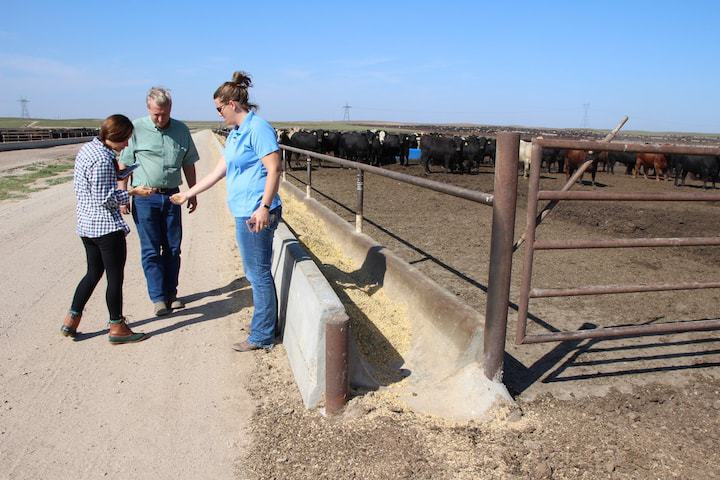
The majority of the cattle are found in Western Kansas as that's where there are a lot of corn fields to feed the cattle. It makes sense as it would be costly to transport feed long distances.
One of the things I learned during the food tour is that all beef is grass fed. It's the finishing of the meat that differs. So, unless the package of meat you are buying states that it is "grass-finished" you may be getting a grain-finished product.
I've always preferred grass-fed and grass-finished meat and it does taste much different than grain-finished. Adding in the corn and other grain produces more fat marbling in the meat and gives the meat a better flavor. I find that fully grass-fed beef has a more "gamey" taste similar to the venison that my husband hunts in the wild.
The cows on the feed lots are sectioned off in different pens. And there is a noticeable difference is size as they progress through the lot. The cattle still primarily on grasses are much thinner than those who have transitioned to eating more grains.
There's 200 cattle in each pen. The feed is mainly corn, some distillers milo, and triticale (a combination of wheat and rye that can be grown efficiently with less water). The Reeve Cattle Company also produces ethanol as it's a byproduct when making cattle feed from grains. Ethanol is a biofuel that's added to gasoline so it burns cleaner.
Dairy Cows at Forget-Me-Not Farms
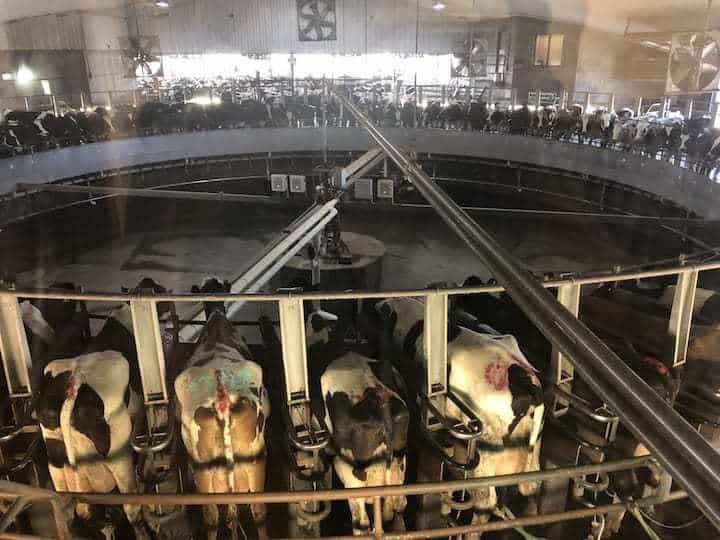
The efficiency of the Forget-Me-Not Farms dairy operation was incredible. They produce about 598,000 pounds of milk each day which leaves in about 10-12 truck loads. The milk goes direct from the milking machine right into a truck with no holding tank in between which allows the dairy production to be more efficient.
Each cow is placed on a big rotary machine that holds 72 cows and runs 24 hours a day. Each cow is on the machine to be milked for about 7 minutes and each cow is milked 2-3 times a day.
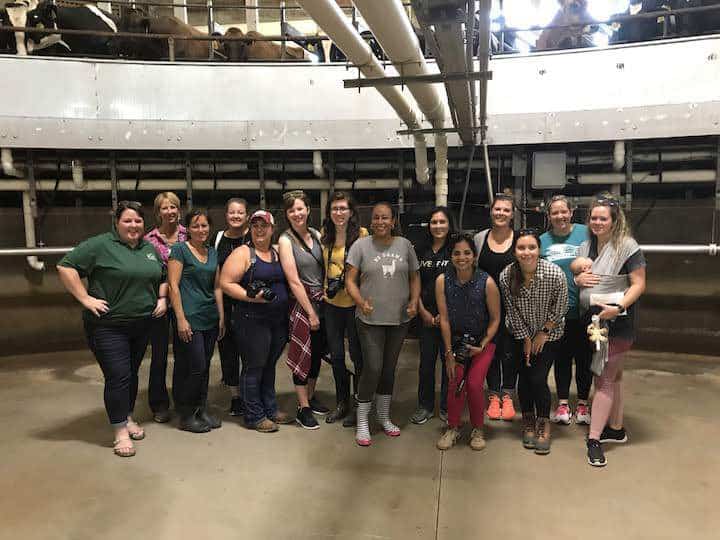
The farm has two of these rotary machines and has about 100 employees. Each machine is cleaned twice a day. The cows on the farm are Holsteins and Jersey cows. All cows are artificially inseminated as there are no bulls kept on the farm.
There are three veterinarians that make regular visits to check on pregnant cows, medicine protocol, and other medical needs. There's also a nutritionist that comes every 5 weeks to determine if any changes are needed to the feed.
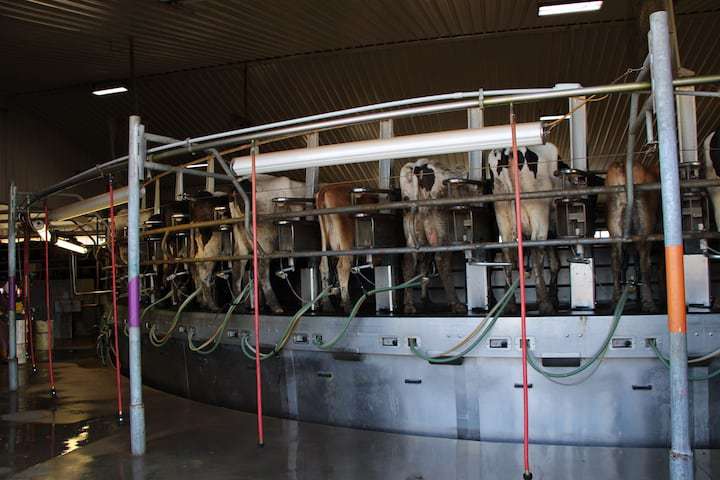
The baby calves born on the farm are taken to a calf ranch. Then they go to another facility which raises the cows to reproduction age.
Eventually, the cows reach an age where they no longer lactate. If the cows are no longer lactating, they can be sold to beef plants.
The World's Largest Hand-Dug Well
Since we spent the night in Greensburg, our tour included a visit to the Big Well. The structure was dug completely by hand and is 109 feet deep and 32 feet in diameter. It's also located in an area that got hit by a massive EF5 tornado in 2007 that completely destroyed much of the town.

Construction of the well began in 1887 and was completed in 1888. Small crews used shovels, picks, pulleys and ropes to build it. The workers were offered pay of fifty cents to a dollar a day. The water from the well was originally used for train steam engines. But it also served as a water source for the town of Greensburg up until 1932.
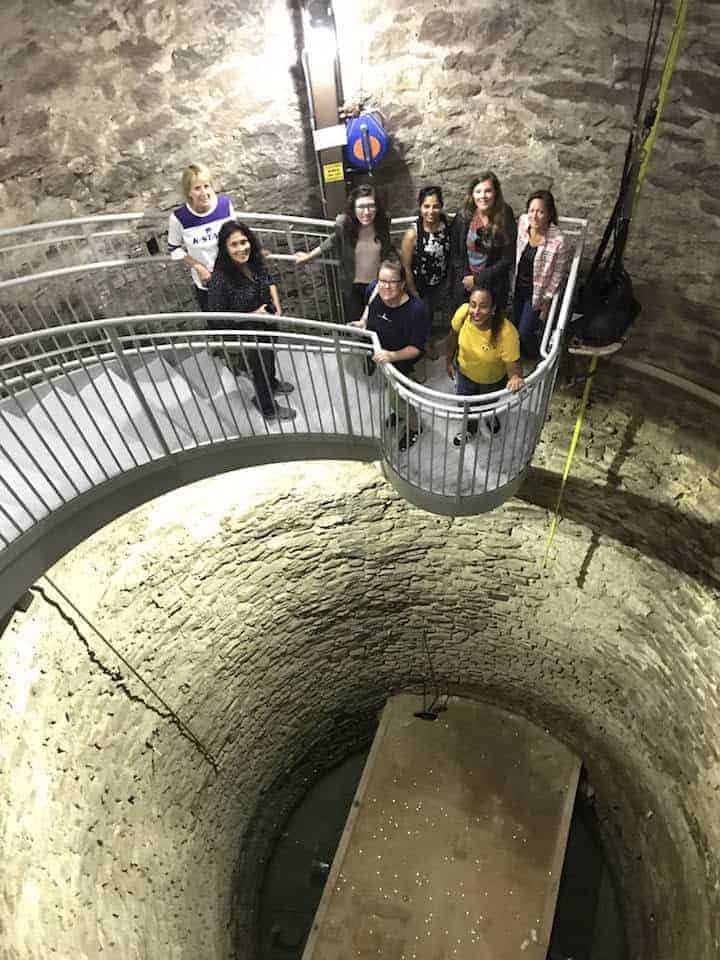
I was amazed at all the stonework needed to construct the well. It must have taken so long to bring all the stone in on wagons. And going that deep into the ground made me realize how much drier the land is out west compared to the where I live in the northeast.
Dalebanks Angus Cattle Pasture

Earlier on the tour, we were told that the best grasses for the cattle to pasture are located in the Flint Hills. So that's where we stopped to find out why. It's where native prairie grasses grow and there's lots of it!
On the pasture, there's about nine to ten acres of land for each cow. The ranch does rotational grazing where a pasture is left dormant for the grasses to grow and then a group of cows are brought in to graze down the grass to about half. The theory is that the grass has to feed the grass, then the grass feeds the soil, and then it can be used to feed the cow.
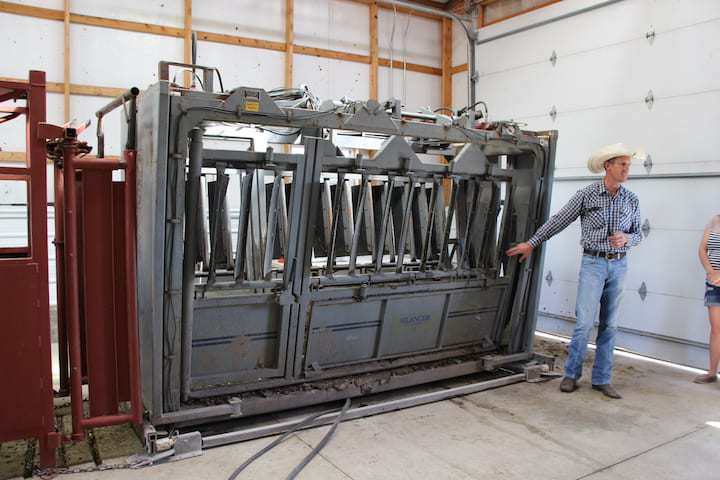
Cattle rancher Matt Perrier showed us the cattle restraint device used to contain cows when administered vaccines. Restraining the cow ensures the proper dose is provided.
Breeding is also done on the ranch and semen is bought for the best genetics. Cattle are bred primarily with artificial insemination but some is done with bulls. They also have surrogate cows to implant embryos and these transplants are done by veterinarians.
Vegetables and more at Juniper Hill Farms
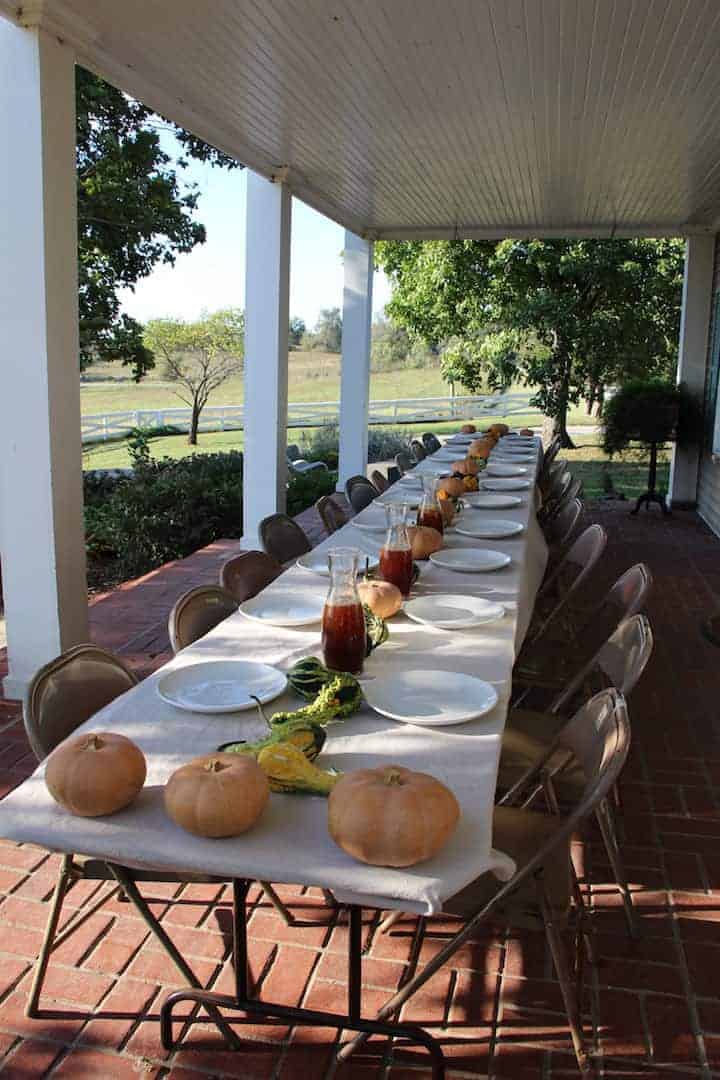
Our final stop on the farm food tour was Juniper Hill Farms in Lawrence where Scott Thellman grows a variety of vegetable along with some hay and row crops. It's a picture perfect farm complete with a red barn.
The front porch on the farmhouse is where we dined to share our last dinner together. Our main course was Angus beef from Good Farms. And we were served some fresh greens in a salad that were grown right on the farm.
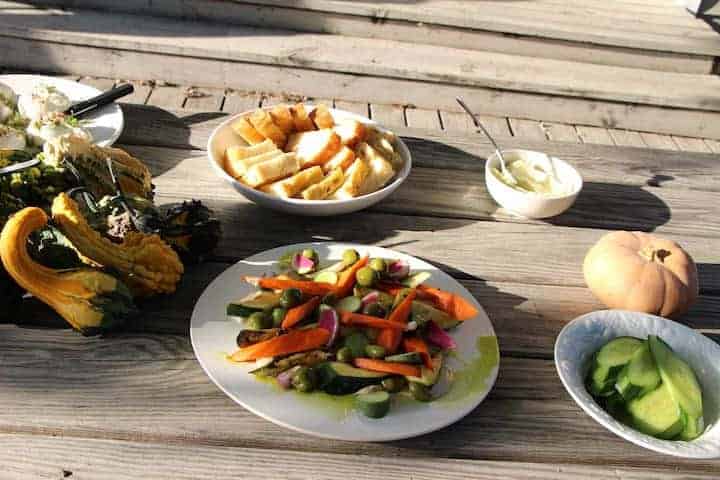
All the food was amazing and super fresh. I enjoyed eating the olives and radishes that were served as appetizers before the main meal. There was also some burrata which is something I had never had before. Although I've been avoiding dairy, I had to give it a try!
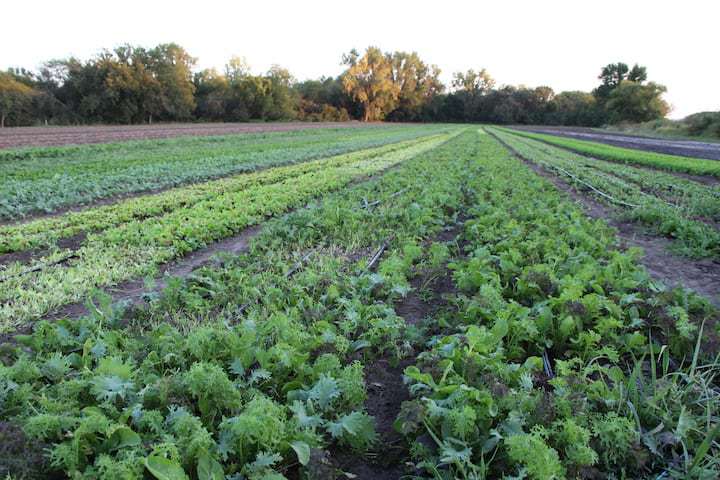
Since it was late in the growing season, the tomato plants in the hoop house were no longer producing. But, there were bins of heirloom variety pumpkins just picked on the farm that were heading to Whole Foods Market.
We did get to visit the fields of lettuce greens. And those would be perfect as a base for my Southwest steak salad. The farm specializes in growing organic produce and since it went that way from the beginning, there was no need for a transition period in the field.
If a farm wants to move from conventional crops to organic, there's a 3 year transition period. And, if there are no subsidies to help with the transition, it can be a financial burden to make the switch. However, right now, the markup on organic produce is much higher so organic farmers typically get a bigger profit on their crops.
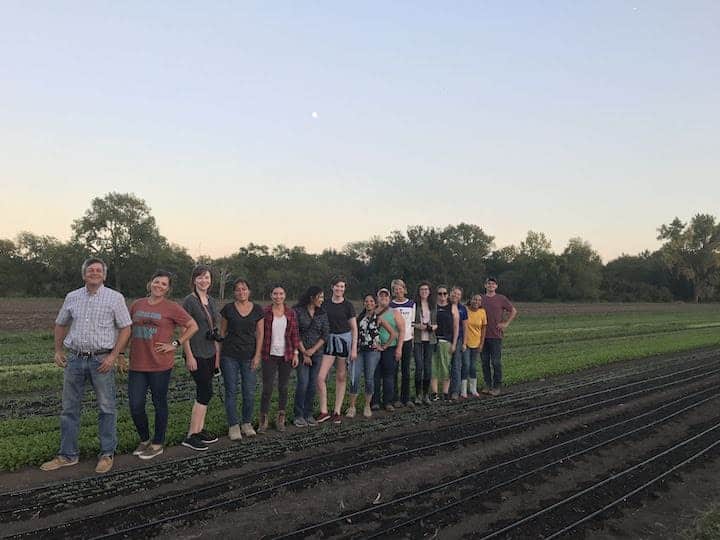
Where does food come from?
So now if someone asks where does food come from, I have some great information to tell on what it really takes to raise meat, produce dairy, and grow vegetables. Getting a first hand look on Kansas farms has helped me to understand the differences between different types of foods. GMOs aren't as scary as I thought they were, and I feel better about conventionally raised meat and produce. There are a lot of requirements that ensure foods from US farms are safe to eat and grown responsibly.
I also met some other fantastic bloggers on the tour. So, I'd like to give a little mention to each one of their blogs below so you can check them out and see what foods they've been eating:
- Shashi at Savory Spin
- Vaishali at The Kitchen Docs
- Madi at Mildly Meandering
- Jessica at A Farm Girls Kitchen
- Silvia at Garden in the Kitchen
- Anna-Marie at Beauty and the Beets
- Leanette at Funtasic Life
Follow us on FACEBOOK, PINTEREST, and INSTAGRAM for even more tasty keto-friendly recipes!
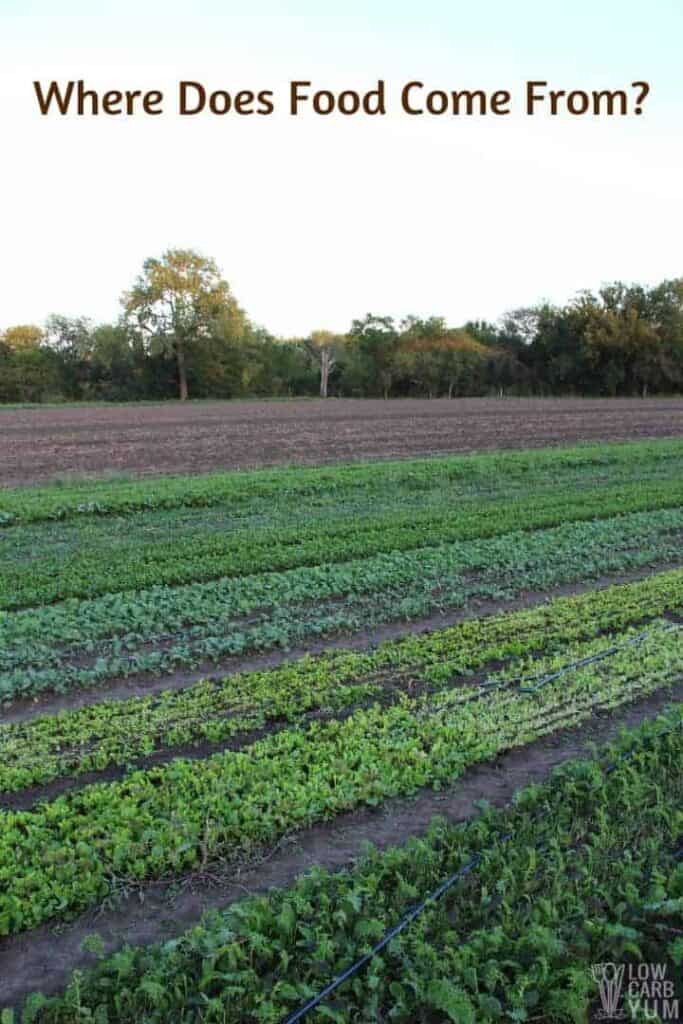
Leave a Reply